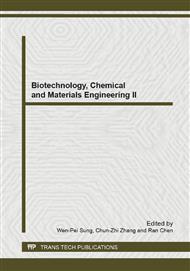p.403
p.410
p.414
p.418
p.423
p.427
p.432
p.436
p.440
Fatigue Properties of Ordinary Portland Cement with Multi-Walled Carbon Nanotubes
Abstract:
The aim of this study was to investigate the fatigue properties of Portland cement/multi-walled carbon nanotube (MWCNTs) composites. Multi-walled carbon nanotubes of varied functionality (unfunctionalised and carboxyl functionalised), synthesized by infusion chemical vapor deposition, and ordinary Portland cement (OPC) were used to produce pastes with a water to cement ratio of 0.45. The mixing amount of MWCNTs ranged from 0.1 wt.% to 0.6wt.%. The fatigue properties of the MWCNTs–OPC was characterised with the type and wt.% loading of MWCNTs used having a significant influence on the number of cycles to failure. The condition and degree of dispersion of the MWCNTs in the matrix at different length scales were studied using field emission scanning electron microscopy. Improvements of the fatigue properties were attributed to the MWCNTs arresting or retarding crack propagation through the cement by a bridging effect and hindering crack propagation. MWCNTs agglomerates were evident in the cement microstructure and the degree of agglomeration depended on the level of the mixing amount and the ability of the MWCNTs.
Info:
Periodical:
Pages:
423-426
Citation:
Online since:
January 2013
Authors:
Keywords:
Price:
Сopyright:
© 2013 Trans Tech Publications Ltd. All Rights Reserved
Share:
Citation:


